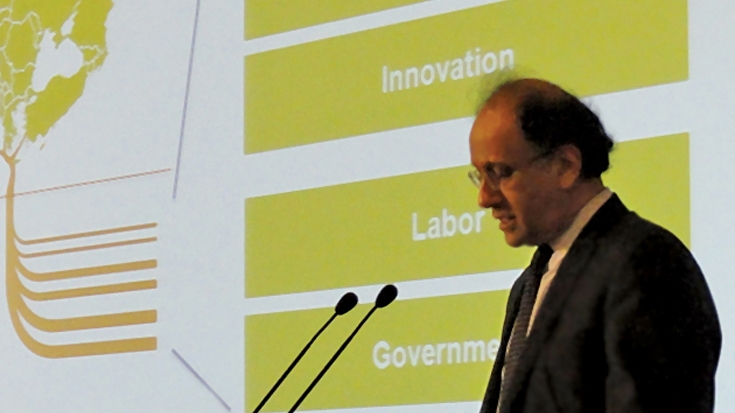The presentation of the report brought together today more than 100 high level officials from the Government, Parliament, private sector, academia and diplomatic community. The discussions focused around the three key recommendations of the report: (i) restart the “convergence machine” that has allowed poorer countries become high income economies; (ii) rebuild “brand Europe” that has helped the region, with one-tenth of the world’s population, account for a third of the global economic output and; (iii) reassess what it takes to remain the world's “lifestyle superpower”, with the highest quality of life on the planet.
Restarting the European “convergence machine”
Between 1950 and 1973, Western European incomes converged towards those in the United States. Then, until the early 1990s, the incomes of more than 100 million people in the poorer southern periphery—Greece, southern Italy, Portugal, and Spain—converged to those of advanced Europe. Starting with the first association agreements with Hungary and Poland in 1994, another 100 million in Central and Eastern Europe were absorbed into the European Union. Another 100 million in the candidate countries in Southeastern Europe are now benefiting from the same aspirations and similar institutions that have helped almost half a billion people achieve the highest standards of living. If European integration continues, the 75 million people in the Ukraine and other countries of the Eastern Partnership will profit in similar ways.
Trade and financial integration are two of the strongest attributes of the European economic model. According to the report, the adjustments needed to strengthen these components are: better management of financial flows, quicker expansion of the modern services trade, and greater mobility of workers.
Rebuilding brand “Europe”
Europe is known for its combination of engineering and design. Since the mid 1990s, while Asia had a financial crisis and recovery and the United States had a technology boom and financial crisis, European enterprise has flourished. With few exceptions, every part of Europe has seen a growth in employment, productivity, and exports.
But during the last decade, two growing shortfalls in productivity are threatening Europe’s global economic influence. The first is that since the mid-1990s, labor productivity in Europe’s leading economies has fallen relative to the United States and Japan. The productivity gap between advanced Europe and the United States today is more than twice what it was in the mid-1990s. The second is that enterprises in southern Europe have become less productive. To be competitive, productivity should have grown by about 3-4 percent each year during the 2000s. Instead, it fell by about 1 percent each year.
According to the report, preserving Europe’s global brand will be somewhat more difficult than restarting convergence, but still well within the continent’s reach. Trade and finance have to be made even more durable so that the continent becomes a single economy. Enterprises in the northern and EFTA economies—already among the most innovative in the world—have to be provided fuller access to markets in the rest of Europe. Governments in southern and Eastern Europe will have to improve the business climate, and the larger continental countries must give their enterprises more economic freedom if they are to compete with North America and East Asia. They must also learn from the US to better harness scientific discovery for commercial use and make their universities magnets for the best and brightest.
Remaining the lifestyle superpower
Europe has provided its citizens more income security and a better work-life balance. With real incomes a quarter short of that of the United States, Europe became a “lifestyle superpower”, with arguably the highest quality of life in human history.
According to the report, Europe will need to make big changes in how it organizes labor and government, because of pressing demographic trends and persistent budget deficits. With a rapidly aging population and falling fertility and without changes in employment, immigration, and pension policies, Europe will lose about one million workers each year for the next five decades and Europe’s labor force is projected to shrink from 325 million to 275 million. At the same time, Europeans have been reducing how much they work. Today, Americans work an extra month compared with the Dutch, French, Germans, and Swedes, and work noticeably longer than less well-off Greeks, Spaniards, Hungarians, and Poles. Men in Poland, Turkey, Hungary, and France retire more than 8 years earlier than in the mid-1960s. By 2007, French men expected to draw pensions for 15 more years than they did in 1965, Polish and Turkish men more than a dozen. This puts enormous pressure on public finances, already strained by the costs of servicing large public debt.
Europe will have to work on many fronts to deal with impending labor shortages: increasing the competition for jobs, improving labor mobility, fixing how work and welfare are facilitated, and rethinking immigration policies. These changes will need a new social consensus.
Apart of these challenges Europe should also move towards a greener economic model. Europe is promoting the clean energy transition, but still but falling short on greener consumption. Bulgaria has become a net importer of carbon emissions as the importance of heavy industries has dropped. It could now focus efforts to take advantage of green growth opportunities in a market that is expected to grow to 3 trillion Euro by 2020.

